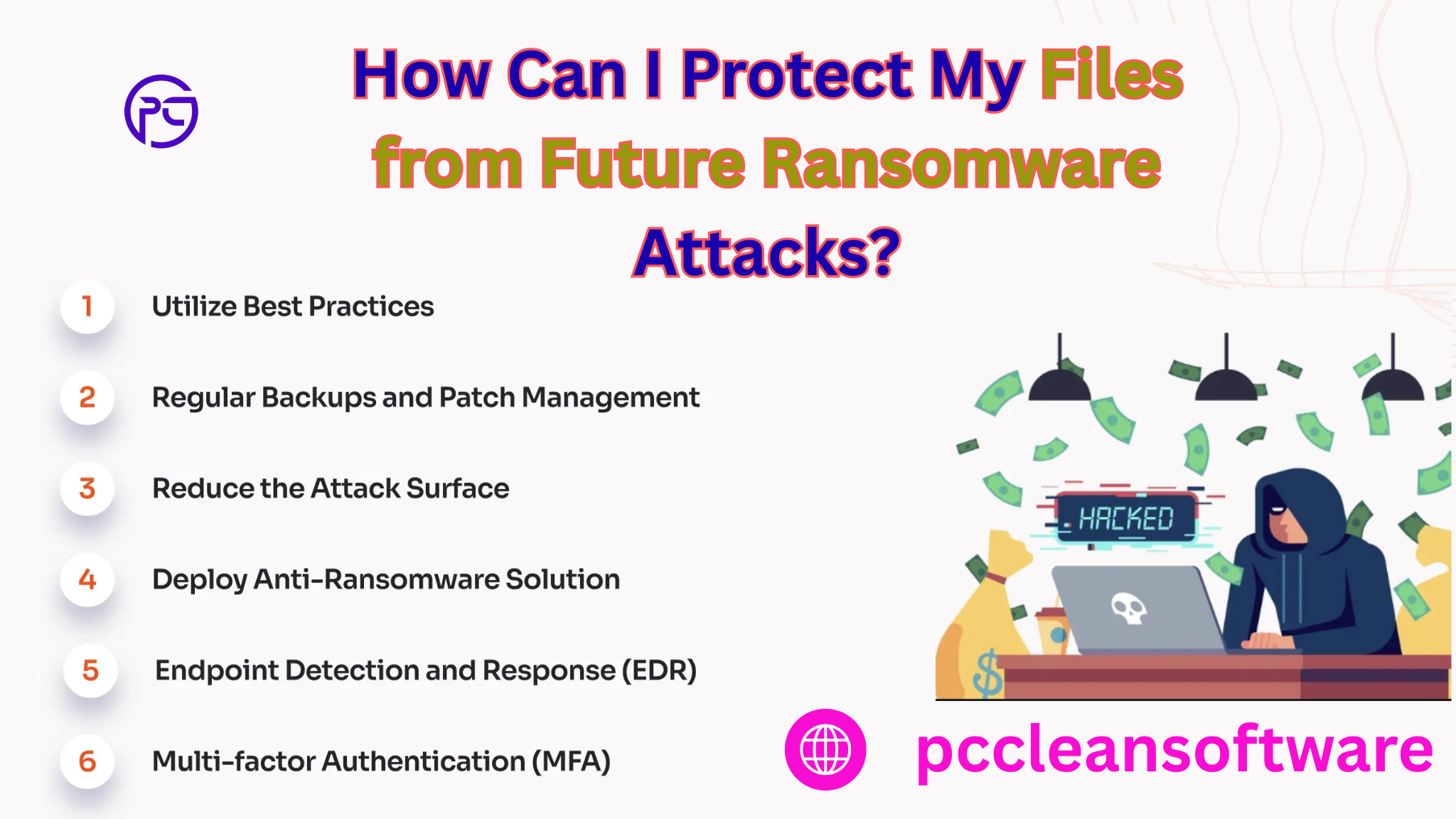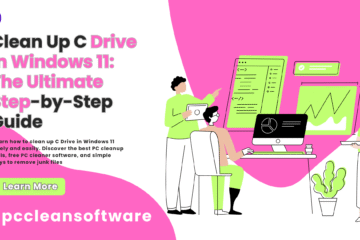Meta Description:
Learn how to protect your files from ransomware attacks using simple steps like backups, updates, and using reliable PC clean software, the best PC optimizer, and PC cleanup tools to keep your computer safe and fast.
Introduction
Imagine waking up one morning, switching on your computer, and finding that all your files — photos, documents, and videos — are locked. A message pops up saying, Pay money to get them back.
That’s what a ransomware attack does.
Ransomware is a type of computer virus that locks or steals your files and asks for money (a ransom) to unlock them. It’s becoming more common and dangerous. The good news? You can protect your computer and files easily — even if you’re not a tech expert.
In this simple guide, we’ll explain how to protect your files from future ransomware attacks using easy methods and some helpful tools like PC clean software, best PC optimizer, and free PC cleanup tools to keep your system safe and healthy.
What Is Ransomware? (In Simple Words)

Ransomware is like a digital kidnapper. It sneaks into your computer through fake emails, unsafe websites, or infected downloads. Once inside, it locks your files so you can’t open them. Then, it demands money — often in cryptocurrency — to give them back.
The trick is: never pay the ransom. There’s no guarantee you’ll get your files back, and it encourages hackers to attack more people. Instead, the smarter option is to protect your computer before it gets infected.
Step 1: Always Keep Your PC Clean and Updated

A messy or outdated computer is more likely to get attacked. When junk files, old software, and unwanted apps pile up, they slow down your system and open the door to security issues.
That’s where PC clean software and the best PC optimizer come in handy.
Use Reliable PC Clean Software
Good PC clean software helps you:
- Remove junk files that slow down your computer.
- Fix broken registry entries (the small settings that keep Windows running smoothly).
- Delete temporary files that hackers can sometimes use to hide viruses.
You can try a free PC cleaner first, but make sure it’s from a trusted company. Many fake cleaners actually install malware
Example of What a PC Cleanup Tool Does
Think of your computer like a messy room. A PC cleanup tool acts like a housekeeper — it organizes things, throws out useless stuff, and makes space for what really matters. Once your system is tidy, it runs faster and is safer from cyber threats.
Step 2: Back Up Your Files Regularly

One of the most powerful ways to fight ransomware is to always have a backup of your files.
Here’s how:
- Use an external hard drive: Copy your important files every week. Keep the drive unplugged when not in use.
- Use cloud storage: Services like Google Drive, Dropbox, or OneDrive automatically save copies of your files online.
That way, even if ransomware locks your PC, you’ll still have clean copies of your files elsewhere.
Step 3: Keep Your Software and Windows Updated

Many ransomware attacks happen because people don’t update their software. Hackers look for old systems with weak points.
To stay safe:
- Turn on automatic Windows updates.
- Keep your browser, antivirus, and PC clean software updated.
- Avoid downloading programs from unknown websites.
Regular updates close security holes and make it harder for hackers to sneak in.
Step 4: Use Antivirus and Firewall Protection

Your antivirus program is like a guard standing at your computer’s gate. It checks everything that tries to enter — downloads, emails, and even USB drives.
- Always keep your antivirus turned ON.
- Update it regularly so it can detect new ransomware types.
- Turn on the Windows Firewall to block suspicious connections.
Even the best PC optimizer often includes built-in protection tools that work alongside antivirus software to boost both performance and safety.
Step 5: Be Smart About Emails and Downloads

Step 6: Optimize Your PC for Speed and Security

A slow computer isn’t just annoying — it can also be unsafe. Lag and crashes sometimes hide malware activity.
That’s why it’s smart to optimize your PC regularly using the best PC optimizer tools.
Benefits of Optimizing Your PC
- Removes junk files and useless programs.
- Speeds up your PC Windows system performance.
- Cleans and repairs your registry (a common hiding place for malware).
- Closes background apps that waste power and slow things down.
If you’re wondering, Is PC cleaning software really necessary the answer is yes, if you choose the right one. It’s not just about speed; it’s about keeping your PC healthy and secure.
Step 7: Turn On Ransomware Protection in Windows

Did you know Windows already has a built-in feature to protect your files from ransomware?
Here’s how to turn it on:
- Go to Windows Security.
- Click Virus & Threat Protection.
- Scroll to Ransomware Protection and enable Controlled Folder Access.
This blocks unauthorized apps from changing or encrypting your files without permission.
Combine this feature with a trusted PC cleanup tool and antivirus, and you’ll have a strong layer of defense.
Step 8: Learn How to Clean Registry Safely

Sometimes, old or broken registry entries can make your system unstable, and that’s when malware finds its way in.
You can clean your registry using a trusted PC clean software.
Never delete registry files manually unless you’re an expert — one wrong move can crash your system.Most PC cleaning software reviews show that automatic registry cleaners are safer, faster, and easier to use for beginners.
Step 9: Use a Multi-Layered Security Plan

Think of your computer security like layers of armor:
- Antivirus software stops known threats.
- PC cleanup tools remove junk and possible malware traces.
- Firewalls block suspicious activity.
- Backups give you a way out if something goes wrong.
Together, they make it nearly impossible for ransomware to cause damage.
Conclusion
Ransomware may sound scary, but protecting your files is simple when you take the right steps.
To summarize:
- Keep your computer clean using trusted PC clean software.
- Remove junk files and optimize your PC for better performance.
- Back up your data regularly to an external drive or cloud.
- Always update your software and stay alert online.
With the right habits and tools — like a free PC cleaner, PC cleanup tool, and best PC optimizer — you can keep your files safe and your computer running like new.
Remember: prevention is always better (and cheaper) than cure. Start protecting your PC today — your future self will thank you.
Top 5 FAQs About Protecting Files from Ransomware
1. What is ransomware and how does it attack my PC?
Ransomware is a type of virus that locks your files and asks for money to unlock them. It can enter your PC through suspicious emails, unsafe downloads, or fake websites. Using PC clean software and a PC cleanup tool can help reduce the risk.
2. Can free PC cleaners really protect my computer?
Yes, trusted free PC cleaners can remove junk files, clean your registry, and optimize PC performance. However, always download from reputable sources and combine them with antivirus software for full protection.
3. How often should I back up my files?
It’s best to back up important files at least once a week. You can use an external drive or cloud storage. Even if ransomware attacks your PC, you’ll still have safe copies of your files.
4. Is PC cleaning software really necessary?
Absolutely! PC cleaning software helps remove junk files, fix registry errors, and optimize PC performance. A clean, optimized PC is harder for ransomware and other malware to attack.
5. What steps can I take right now to protect my files?
- Use PC cleanup tools to remove junk and optimize your PC.
- Keep your Windows and software updated.
- Use antivirus and enable firewall protection.
- Backup your files regularly.
- Be cautious with emails and downloads.
Disclaimer
The information provided in this article is for educational and informational purposes only. While we aim to provide accurate and up-to-date advice, we cannot guarantee complete protection against ransomware or other computer threats. Use the tips, software, and tools mentioned at your own risk. We are not responsible for any loss of data, damage to your computer, or other consequences that may occur. Always back up your files and consult a professional if needed.



